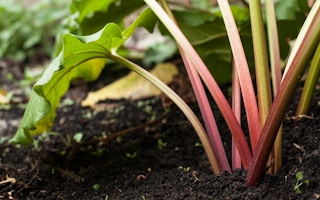Rhubarb and other simple green vegetables could be the source of materials for a new generation of batteries with the potential to transform energy systems, according to new research by Harvard University.
The prospect of low-cost storage has long been a nirvana for the renewable energy industry, the intermittent nature of wind and solar energy restraining their competitiveness against fossil fuels such as coal.
Globally, companies and governments are pouring billions of dollars into developing batteries that can store energy safely, cheaply and at scale.
Flow batteries, a type of rechargeable fuel cell using chemical compounds dissolved in liquids, have had some of the biggest advances but development has been held back by the high cost of materials used, such as vanadium.
The research, published in Nature on Thursday, holds the promise of sharply reduced costs, with the material demonstrated to work costing a third of vanadium or less, said Michael Aziz, a Harvard professor of materials and energy technologies and one of the report’s authors.
”We’ve introduced the world of organic chemicals to flow batteries,” Professor Aziz said.
”The ones we have used are … very abundant. They work really well and they’re safe.”
While the molecules used were sourced from crude oil, the material could as easily have been sourced from rhubarb or most other green plants, Professor Aziz said.
The research has ”connected the world of energy storage of flow batteries with small molecules, where there’s so many possibilities to fine-tune the properties and get the properties you need”, he said.
Unlike lithium, for instance, there is little chance the batteries will ignite.
”Our molecules are deliberately dissolved in water, so they don’t catch fire,” he said.
The work, funded by the US government, is likely to result in a three-year extension to develop a commercial technology.
The aim is to produce a battery capable of storing 24 kilowatt hours of energy, which is the equivalent output of a typical rooftop solar photovoltaic array over eight hours, before scaling up to much larger units.
”It could enable serious, cost-effective storage of solar and wind and allow us to generate a very large fraction of our electrical energy … without burning fossil fuels,” Professor Aziz said.
The Nature paper was based on research that demonstrated the battery’s effectiveness over 15 runs.
”Now we’ve done more than 100 with no signs of degradation, which is a very good sign,” Professor Aziz said, adding that commercialisation would require performance standards being maintained for thousands of runs.
The introduction of low-cost batteries may also contribute to the spread of solar and wind generation, since electricity networks in many parts of the world - including regions of Australia - are reaching limits of how much renewable energy they can absorb without losing reliability.








